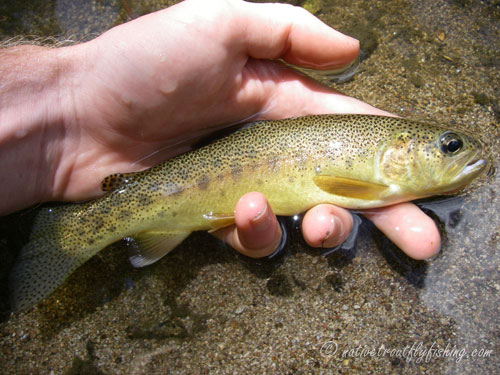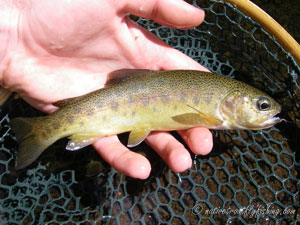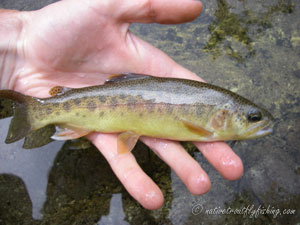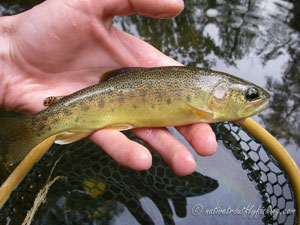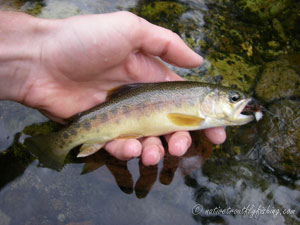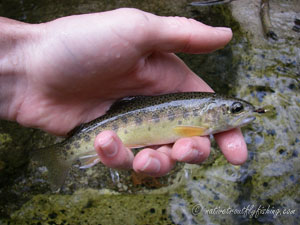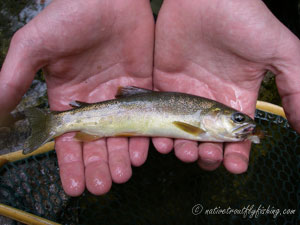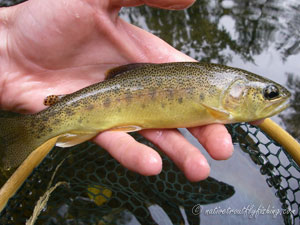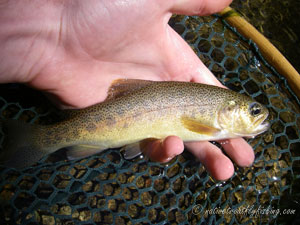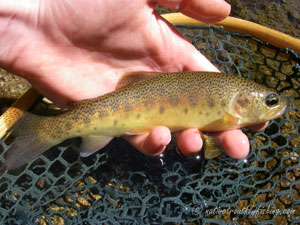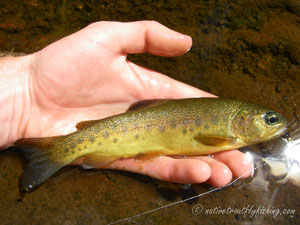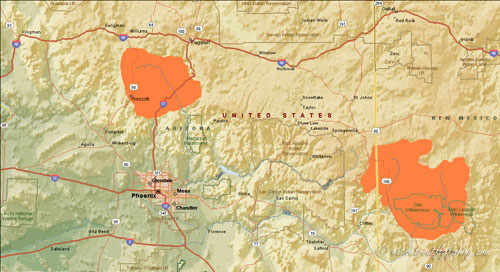Gila Trout
Oncorhynchus gilae gilae
A Gila Trout from a small stream in the Gila Wilderness Area of New Mexico.
Introduction
The Gila Trout was first described as a species in 1950 (Miller 1950) and were native to the upper Gila and Verde watersheds of Arizona and New Mexico but have declined significantly since the 1800s. The Verde River population may have represented an intermediate between the Gila and Apache Trout, however this population went extinct by the 1950’s (Miller 1950) and little is known about the original native trout (Behnke 2002). Starting in 1999, Gila Trout were reintroduced into Dude Creek in the Verde River drainage with a second population established in the upper West Fork of Oak Creek in 2015, returning them to the watershed for the first time in over 50 years. Gila Trout historically were considered to be closely related to Cutthroat (Needham and Gard 1959, Needham and Gard 1964), but genetics indicate that they likely represent a relic lineage related to Rainbow Trout that migrated up the Colorado River during a period when the climate was cooler (Loudenslager et al. 1986, Behkne 1992, Dowling and Childs 1992, Riddle et al. 1998).
Life History Information
Gila Trout historically occurred as both fluvial and stream resident populations. However, due to their rapid disappearance across their native range, little is known about the fluvial life history form that likely occurred in the Gila and Verde River systems. All the remaining native populations before reintroduction efforts began were in isolated headwater streams with stream resident life history patterns. Gila Trout like other Pacific trout are iteroparous spring spawners. Spawn timing is determined by water temperature, day length and stream flows and generally occurs once stream temperature reaches 46° F (8° C) in early April in lower elevations through June in the higher elevations (Rinne 1980). According to Behnke (2002), Gila Trout typically spawn for the first time at around age-three and at a size of 5” to 9” (13 to 23 cm), with females of 9” (23cm) long producing around 300 eggs. Spawning generally occurs in water 2.4” to 6” (6 to 15 cm) deep and redds are constructed in fine gravel or coarse sand substrate (Rinne 1980). Adult Gila Trout typically live to age-five (Turner 1986), although individuals as old as age-nine have been observed (Nankervis 1988). Fry generally emerge from the gravel about 8 to 10 weeks after they were spawned (Rinne 1980) and move into stream margins or side channels as nursery rearing habitat (Behnke 1992). As Gila Trout grow, they seek out the better habitat provided by pools, undercut banks and logjams. While Gila Trout require cold clean water to survive, Lee and Rinne (1980) showed that Gila Trout able to survive temperatures up to 80° F (26.7° C) for limited periods of time and will continue to feed until temperatures exceed 73° F (22.8° C). Stream resident Gila Trout are quite territorial, with a typical home range of 350’ (107 m) (Rinne 1982), although some individuals have been observed traveling up 0.9 miles (1.5 km). Within stream resident populations, migrations are typically to seek overwintering or summer refugia pool habitat. Gila Trout are primarily drift feeders with a diet consisting primarily of aquatic and terrestrial insects (Regan 1964) although larger Gila Trout may prey on dace or smaller Gila Trout (Van Eimeren 1988, Propst and Stefferud 1997). While the availability of food plays a large role in population sizes, Gila Trout density tends to be greater in the cooler higher elevation reaches of streams (Propst and Stefferud 1997). Although Gila Trout were not known to have native lacustrine populations, stocked Gila Trout appear to thrive in lakes and the world record Gila Trout was caught in Goldwater Lake in Arizona in 2018 measuring 23” (58 cm) weighing 5.12 lbs (2.3 kg).
Status
Gila Trout have long been one of the rarest trout in North America and by the time of their description as a full species in 1950, Gila Trout had vanished throughout most of their native habitat and only five isolated stream resident populations remained (Miller 1950, USFWS 2003). This led to Gila Trout being listed as endangered in 1967 under the United States Endangered Species Preservation Act of 1966 (USFWS 1967) and reaffirmed as endangered under when the Endangered Species Act (ESA) was enacted in 1973 (USFWS 1975). Although Gila Trout have started to recover today due to extensive conservation efforts, many of the issues that initially led to their decline continue to affect them and hinder recovery efforts.
The decline of the Gila Trout has stemmed from a number of sources, including overfishing, habitat destruction and the introduction of non-native trout. As Gila Trout inhabit in an arid region but are dependent on cold clean water, they are particularly susceptible to habitat destruction. Early declines of Gila Trout likely stemmed from logging and overgrazing, which altered stream flows, increased water temperatures and increased sediment loads (Miller 1950). This led poor survival for eggs made downstream reaches of the Gila River formerly inhabited by Gila Trout unsuitable for them. During the same time, overfishing reduced Gila Trout abundance and resulted in the introduction of non-native hatchery to supplement fisheries.
The introduction of non-native trout has played the largest role in the demise of Gila Trout across their native range. As with other trout that have been isolated for a long time, Gila Trout are not well suited to cope with competition with introduced species. This has been especially problematic with Brook Trout and Brown Trout, which are fall spawners, giving their offspring of a competitive advantage as they emerge months before the native Gila Trout allowing them to gain size and secure the best territories, forcing the juvenile Gilas into marginal habitat. Brown Trout are highly piscivorous and once they reach a substantial size, they feed heavily on the smaller Gila Trout (Mello and Turner 1980). While competition and predation are problematic, hybridization with Rainbow Trout is a major cause of the decline or Gila Trout (Miller 1950, Behnke 2002, USFWS 2003). Gila Trout are related closely enough to Rainbow Trout to hybridize with them, which leads genetic dilution, loss of local adaptation and after many years of stocking Rainbows, fish with only slight Gila traits remain (Dowling and Childs 1992). Since Gila Trout were listed as Endangered, hybridization with Rainbow Trout has been detected in two of the original five remaining populations (Riddle et al. 1998), hindering efforts to recover the species.
Since their initial listing in 1967, Gila Trout conservation efforts have faced an uphill battle. During the 1980’s significant progress toward the recovery of Gila Trout was made, with barriers to bar access to non-native trout being constructed and a number of new Gila Trout were populations established. However, in 1989 when Gila Trout were proposed to be down-listed to threated (USFWS 1987), a series of natural disasters hit the arid environment of the Gila watershed and set restoration efforts back significantly. First a severe drought, resulted in low stream flows and high temperatures, and severely reduced the abundance and distribution of Gila Trout across their range. McKnight Creek was one of the hardest hit streams by this drought with its populations reduced by approximately 90% (Propst et al. 1992). With the drought came the devastating Divide Fire, which burned approximately 61,000 acres (24,700 hectares) in the Main Diamond Creek watershed. Shortly after the fire a flood swept through the basin washing ash into the stream and eliminating, the main Diamond Creek population, which had been one of the original five relict populations and had hosted the strongest remaining Gila Trout population. Luckily, the New Mexico Fish and Game Department had the foresight to remove 566 Gilas from the stream during peak of the fire and transplanted 200 of them into McKnight Creek with the remained being used for hatchery broodstock, preserving some of the Main Diamond lineage. After the 1989 events, Gila Trout abundance was reduced by 80% to 90% across their native range (Propst et al. 1992). Since the Divide Fire in 1989, Gila Trout conservation has been as story of two steps forward and one step backwards with successes from reintroductions being challenged by losses due to wildfires. However, significant progress has been made and in 2006 the Gila Trout had recovered enough to warrant them being down listed to threatened status (USFWS 2005). Since then, some limited catch and release opportunities for Gila Trout have been opened in New Mexico and Arizona is also starting to reestablish populations across the state. Fires continue to be problematic and with climate change are one of the greatest threats to Gila Trout (Dauwalter et al. 2017), but there are currently around 60 populations of Gila Trout and the future looks much brighter for the species than it did when they were described in 1950.
U.S. Fish and Wildlife Service Gila Trout Conservation Story
Description
Gila Trout are bronze to olive-brown on the back transitioning to a golden-yellow color along their sides and often exhibit a light reddish or pink band along the lateral line and a copper color on their gill plates. During spawning these features become more pronounced and the normally white belly or Gila Trout may become streaked with yellow or a reddish orange color. Gila Trout have small profuse spots distributed across their body primarily above the lateral line. Most adult Gila Trout have a yellow cutthroat mark and may retain their parr marks as well. As Gila and Apache Trout diverged from a common ancestor, they share a number of similarities. Both Gila and Apache Trout have deeper and more compact bodies than other Pacific trout and tend to have longer fins, with Gila Trout having the longest adipose fin of any Pacific trout. The dorsal, pelvic and anal fins on the Gila Trout are tipped with white, as is common among many Rainbow Trout populations. Similar to Apache Trout, some Gilas may display "bandit" like horizontal bars across the irises of their eyes.
Stream Resident Form
Click on images to view a larger picture
Native Range
A map of the original native range of the Gila trout. Data Source: Behnke (2002) and Propst et al. (1992).
References
Behnke, R. J. 1992. Native trout of western North America. American Fisheries Society Monograph 6. American Fisheries Society, Bethesda, Maryland.
Behnke, R.J. 2002. Trout and Salmon of North America. Chanticleer Press, New York.
Dauwalter, D.C., J.E. Williams, J. McGurrin, J.E. Brooks and D.L. Propst. 2017. Vulnerability of Gila trout streams to future wildfires and temperature warming. Wild Trout Symposium XII—Science, Politics, and Wild Trout Management: Who’s Driving and Where Are We Going? Publisher: West Yellowstone, Montana Editors: Robert F. Carline. 192-205.
Dowling, T.E. and M.R. Childs. 1992. Impact of hybridization on a threatened trout of the southwestern United States. Conservation Biology 6(3): 355-364.
Lee, R.M and J.N. Rinne. 1980. Critical thermal maxima of five trout species in the Southwestern United States. Transactions of the American Fisheries Society 109: 632-635.
Loudenslager, E.J., J.N. Rinne, G.A.E. Gall and R.E. David. 1986. Biochemical genetic studies of native Arizona and New Mexico trout. The Southwestern Naturalist 31(2): 221-234.
Mello, R., and P.R. Turner. 1980. Population status and distribution of Gila trout in New Mexico. Endangered Species Report No. 6, U.S. Fish and Wildlife Service, Albuquerque, New Mexico.
Miller, R.R. 1950. Notes on the cutthroat and rainbow trouts with the description of a new species from the Gila River, New Mexico. University of Michigan Press 529: 1-46.
Nankervis, J.M. 1988. Age, growth and reproduction of Gila trout in a small headwater stream in the Gila National Forest. Unpublished. M.S. Thesis, New Mexico State University, Las Cruces, New Mexico.
Needham P.R. and R. Gard. 1959. Rainbow trout in Mexico and California with notes on the cutthroat series. University of California Publications in Zoology 67:1-124.
Needham, P.R. and R. Gard. 1964. A new trout from central Mexico: Salmo chrysogaster, the Mexican golden trout. Copeia 1964(1): 169-173.
Propst, D.L., J.A. Stefferud and P.R. Turner. 1992. Conservation and status of Gila trout (Oncorhynchus gilae). The Southwestern Naturalist 37(2): 117-125.
Propst, D.L. and J.A. Stefferud. 1997. Population dynamics of Gila trout in the Gila River drainage of the south-western United States. Journal of Fish Biology 51: 1137-1154.
Regan, D. M. 1966. Ecology of Gila trout in Main Diamond Creek in New Mexico. U.S. Department of the Interior, Fish and Wildlife Service, Technical Papers of the Bureau of Sport Fisheries and Wildlife No. 5.
Riddle, B.R., D.L. Propst and T.L. Yates. 1998. Mitochondrial DNA variation in Gila trout, Oncorhynchus gilae: Implications for management of an endangered species. Copeia 1998(1): 31-39.
Rinne, J.N. 1980. Spawning habitat and behavior of Gila trout, a rare salmonid of the Southwestern United States. Transactions of the North American Fisheries Society 109: 83-91.
Rinne, J.N. 1982. Movement, home range, and growth of a rare southwestern trout in improved and unimproved habitats. North American Journal of Fisheries Management 2: 150-157.
Turner, P. R. 1986. Restoration of the endangered Gila trout. Proceedings of the Annual Conference of the Western Association of Fish and Wildlife Agencies 66:122-133.
Van Eimeren, P. A. 1988. Comparative food habits of Gila trout and speckled dace in a southwestern headwater stream. Unpublished M.S. Thesis, New Mexico State University, Las Cruces, New Mexico.
USFWS (U.S. Fish and Wildlife Service). 1967. Native fish and wildlife, endangered species. Federal Register 32:4001.
USFWS (U.S. Fish and Wildlife Service). 1975. Endangered and threatened wildlife and plants. Federal Register 40:44415-44429.
USFWS (U.S. Fish and Wildlife Service). 1987. Endangered and threatened wildlife and plants; proposed reclassification of the Gila trout (Salmo gilae) from endangered to threatened, proposed rule. Federal Register 52:37424-37427.
USFWS (U.S. Fish and Wildlife Service). 2003. Gila trout recovery plan (third revision). Albuquerque, New Mexico. 60 pages.
USFWS (U.S. Fish and Wildlife Service). 2005. Reclassification of the Gila Trout (Oncorhynchus gilae) from Endangered to Threatened with Regulations. Federal Register 70:24750-24764.
Contact
Feel free to contact me if you have any questions or comments
Gila Trout Links
New Mexico Department of Game and Fish - Gila Trout Angling
Arizona Department of Game and Fish - Gila Trout Angling
Western Native Trout Initiative - Gila Trout
Native Trout Links
Truchas Mexicanas' - Native Trout of Mexico
Balkan Trout Restoration Group
Trout and Seasons of the Mountain Village - About Japanese Trout
Western Native Trout Challenge
California Heritage Trout Challenge
Fly Fishing Blogs
Dave B's Blog: Fly Fishing for Native Trout
The Search for Native Salmonids
Conservation Links
Western Native Trout Initiative
Fly Fishing Links
Fishing Art Links
Americanfishes.com - Joseph R. Tomelleri
